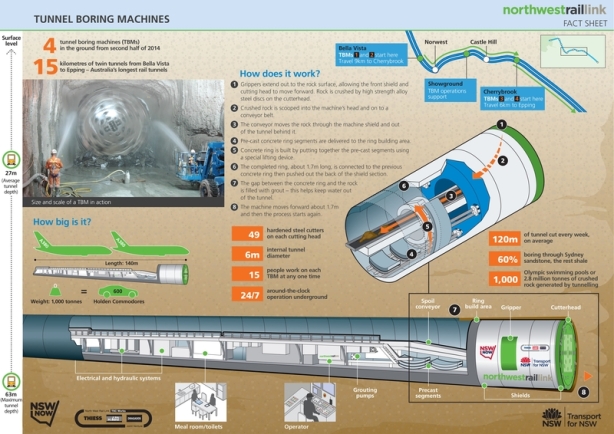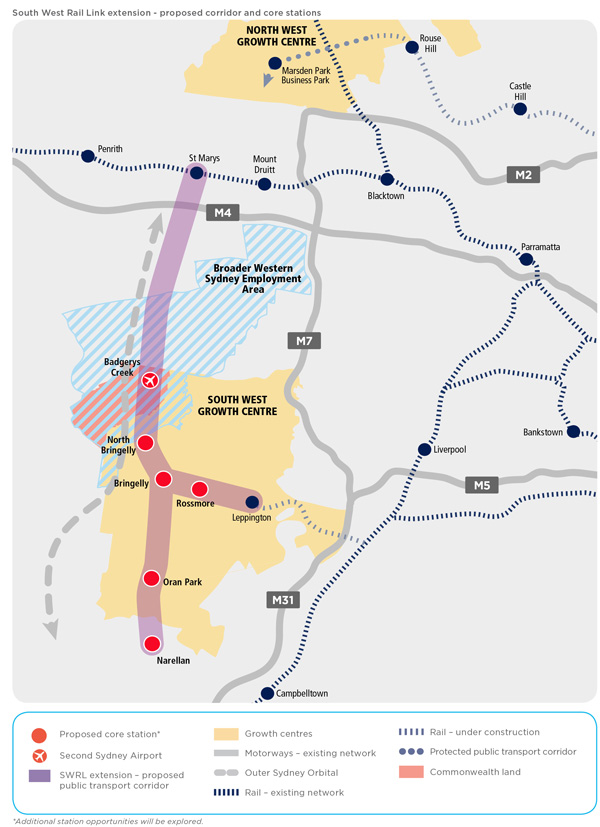Infrastructure NSW released an update to its infrastructure plan in November 2014. Unlike the 2012 report, this one puts a greater emphasis on rail. Here is a (belated) overview of the main recommendations for the rail network.
Sydney Trains/NSW TrainLink (p. 34)
Major upgrades will focus on the T1 Lines, which are expected to see stronger growth in demand than other lines. These include lengthening of platforms, to allow longer trains to stop at certain stations; amplification of track, akin to adding more lanes to a road; and improved signalling, which allows more frequent train services without compromising safety.
The longer platforms will primarily benefit intercity train services, with new intercity trains to be 12 cars in length compared to the current 8 car trains. Meanwhile, the business case for improved signalling is expected to be completed over the next 18 months.
No specific details are given on where track amplifications will occur. A commonly touted corridor is on the Northern Line between Rhodes and West Ryde, which would upgrade the entire Strathfield to Epping corridor up to 4 tracks. This would allow service frequencies to be increased along this corridor while still maintaining a mix of all stops and express services. Such capacity improvements are necessary for Upper Northern Line trains that currently reach the city via Chatswood to instead be diverted via Strathfield when the Epping to Chatswood Line is closed down for upgrades as part of the North West Rail Link project in 2018.
Sydney Rapid Transit (pp.37-38)
Construction on a Second Harbour Rail Crossing is to begin in 2019, with completion in 2024-25. It has a BCR (Benefit to Cost Ratio) of 1.3 to 1.8, meaning that every $1 spent on the project will produce benefits of $1.30 to $1.80. The total cost will be approximately $10.4bn, with $7bn to come from privatisation of state electricity assets and $3.4bn from existing funding already committed. Additional stations will be considered at Artarmon, Barangaroo, and either Waterloo or Sydney University; which the report recommends partly being funded by beneficiaries of the new stations, a concept known as “value capture” (p. 146). The current plan has the line connecting to Sydenham Station via tunnel, rather than utilising the existing corridor between Erskineville and Sydenham which has been reserved for an additional pair of tracks.

Proposed new stations include Artarmon (not shown), Barangaroo, and either Sydney University or Waterloo. Click to enlarge. (Source: Transport for NSW.)
Improving efficiency (p. 35)
Transport for NSW will further investigate the effectiveness of off-peak pricing and improved shoulder peak services on spreading demand. The report notes that, following the October 2013 timetable changes, improved frequencies during the shoulder peak periods (the time immediately before and after peak hour) saw 5% of peak hour journeys shift from peak hour to the shoulder. Transport for NSW notes that this represents “more than two years of patronage growth”, adding however that “this option is not ‘cost free’: additional rolling stock may be required to provide these services on some lines”. Despite these concerns, it is likely that improved efficiency can at the very least defer the need for more expensive capital expenditure to expand the rail network.
Light rail (p. 40)
Two light rail projects are discussed, the first being and extension to the existing Inner West Line out to White Bay where significant urban development is planned; which the second is an extension of the proposed CBD and South East Line to either Maroubra (1.9km), Malabar (5.1km), or La Perouse (8.2km). Neither of these extensions have funding attached to them.

Potential extensions to the CBD and South East Light Rail to Maroubra, Malabar, or La Perouse. Click to enlarge. (Source: Infrastructure NSW, State Infrastructure Strategy Update 2014, p. 40.)
Freight (pp. 62-63, 65)
A Western Sydney Freight Line is mentioned, as is a Maldon to Dombarton Railway and associated improvements to the Southern Sydney Freight Line (SSFL). The latter would link up Port Kembla to the SSFL in South West Sydney, thus removing freight trains from the T4 Line in Southern Sydney. Such a move is likely a prerequisite for increase passenger frequencies on the T4 Illawarra Line as well as extending Rapid Transit Services from Sydenham to Hurstville at some point in the future.

The Maldon to Dombarton Railway would allow freight trains to travel between Sydney and Port Kembla without using the T4 Line through Hurstville and Sutherland. Click to enlarge. (Source: Infrastructure NSW, State Infrastructure Strategy Update 2014, p. 65.)
Commentary: What’s missing and what’s next?
No mention is made of a rail line to the Northern Beaches, the Parramatta to Epping Rail Link, an extension to the T4 Eastern Suburbs Line, or a CBD bus tunnel. The last 2 of these projects were proposed by Infrastructure NSW in its original 2012 report, designed to eliminate the need for light rail through the CBD. With the NSW Government opting to go ahead with the surface light rail option, both of these projects appear to have been dropped by Infrastructure NSW.
Infrastructure NSW’s combatative approach also appears to have been dropped replaced with a more cooperative approach to transport planning with Transport for NSW. Whereas in 2012 the Infrastructure NSW report was seen as an alternative to the Transport for NSW Transport Master Plan, and an alternative that focussed more on road based transport rather than rail based transport; this 2014 update reinforces, rather than contradicts Transport for NSW. It’s difficult to look past the departure of Infrastructure NSW’s inaugural Chairman and CEO, Nick Greiner and Paul Broad (both strong advocates for roads and road based transport), when looking for a reason why this may have happened.
Looking towards the future, the $20bn privatisation of 49% of the electricity distribution network in 2016 will provide funding for a decade – in particular to fund the construction of the Second Harbour Crossing, $7bn from privatization money is to be added to the existing $3.4bn allocated to it, with construction to begin in 2019 and the project completed by 2024-25. If the Premier Mike Baird has his way then construction will begin in 2017, potentially fast tracking this project to 2023. This would be 4 years after the opening of the NWRL, a welcome change to delays and deferrals that NSW has become used to.
Additional expansions of the transport network that come after that are currently unfunded and uncommitted. These include any extension to the North West and South West Rail Links, light rail to Maroubra and White Bay, and the Outer Western Orbital Freeway.
One option is that the remaining 51% could be sold off to pay for it. Alternatively, these projects could be funded out of consolidated revenue, built at a slower pace than would otherwise be the case. Following the coming decade of strong additions to Sydney’s stock of infrastructure, this may be an acceptable option. Either way, the 2015 election will not settle the debate over privatisation. This will be an issue that will remain on the table for decades to come.







